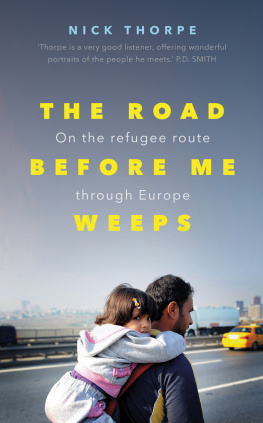
JUST LIKE US
THE TRUE STORY OF FOUR MEXICAN GIRLS COMING OF AGE IN AMERICA
HELEN THORPE


Scribner
A Division of Simon & Schuster, Inc.
1230 Avenue of the Americas
New York, NY 10020
www.SimonandSchuster.com
Copyright 2009 by Helen Thorpe
All rights reserved, including the right to reproduce this book or portions thereof in any form whatsoever. For information, address Scribner Subsidiary Rights Department, 1230 Avenue of the Americas, New York, NY 10020.
First Scribner hardcover edition September 2009
SCRIBNER and design are registered trademarks of The Gale Group, Inc., used under license by Simon & Schuster, Inc., the publisher of this work.
For information about special discounts for bulk purchases, please contact Simon & Schuster Special Sales at 1-866-506-1949 or business@simonandschuster.com.
The Simon & Schuster Speakers Bureau can bring authors to your live event. For more information or to book an event, contact the Simon & Schuster Speakers Bureau at 1-866-248-3049 or visit our website at www.simonspeakers.com.
Designed by Carla Jayne Jones
Manufactured in the United States of America
1 3 5 7 9 10 8 6 4 2
Library of Congress Control Number: 2009022722
ISBN 978-1-4165-3893-6
ISBN 978-1-4391-6625-3 (eBook)
FOR TEDDY
CONTENTS

INTRODUCTION

A few years ago, I had the honor of meeting four young women who were going to high school in Denver, Colorado. They had been friends since middle school; by the time I met them, they knew almost everything about one another. All four came from families who had emigrated from Mexico, and each had at least one parent who had crossed the border without a legal entry visa. The girls inherited various standings: one was born a U.S. citizen, one became a legal resident, and two lacked documents. They were armed to brave adulthood in different ways, and as they passed the milestones of their youth, their legal status began to affect how they saw one another. I thought the story of their interconnected relationships illuminated the vagaries of current immigration law. Also, since they were about to leave the safety of high school for an uncertain future, I wanted to know what would happen to them.
The question of what it was like for the girls to come of age in an adopted homeland intrigued me because I thought I shared something in common with them. Both of my parents were born and raised in Ireland and emmigrated to England in search of work. I was born in London in 1965 and a year later we emmigrated to the United States, which gave me an odd sense of dual identity. I was from another place, yet it didnt feel that way most of the time, as the only country I really knew was this one. At the same time, I did not feel 100 percent American, either. I grew up carrying a green card until I was twenty-one and became a naturalized citizen. By then I had learned how to hold fealty to two places: I had grown up making transatlantic telephone calls to faraway relatives, mailing overseas packages on the holidays, and traveling to see my Irish cousins every other summer. When I was in high school, I had to explain what freshman and sophomore meant to my mother, because she had never heard those words before. But of course I had no idea what it was like to be an illegal alien. I didnt know what it was like to translate for a parent, or to purchase fake documents, or to hide the truth about my identity. I was drawn to the four girls because we had something in common and we had nothing in common, because they had been assigned a position at the bottom of society and I had gained a spot at the top. I wanted to know if they were anything like the person I had been at their age and what kind of relationship they had with America.
After I had been following the girls for more than a year, fate drew my family into the immigration debate in a shocking and personal way. John Hickenlooper, the mayor of Denverto whom I am marriedbecame engulfed in a local political scandal, one that acted like gasoline on the already fiery debate over illegal immigration. I had been working as a journalist for fifteen years when I met John and was used to operating independently and without obvious conflicts of interest; suddenly there was no way for me to write about the girls without addressing a crime that affected my own spouse. In the process, I also came to know and care about members of a family that had been shattered by the actions of an illegal immigrant. I had imagined that the girls and I would stay sequestered in the part of town where they had spent their formative yearsthat we would remain in the barriobut we did not. Instead, a suburban family suffered the worst kind of loss, my own family became embroiled in controversy, the political world became obsessed with illegal immigrants, and the illegal immigrants I knew took to the streets. Fortune handed me a messy braid of narratives, spliced together by bizarre connections. In the end, though, this is what immigration is like: inherently messy. The issue bleeds. And we are all implicated.
Im not sure if the girls expected something in return for the hours they spent with me. I made it clear on several occasions that I could not give them financial assistance, but sometimes I wondered if they expected some other, less tangible form of aid. Eventually, I came to see that the girls craved legitimacy, and I suspect they found it in some roundabout way by spending time with me. When I asked them about their lives, it might have seemed to them as though Denver itself was interested in who they weregiven the position my husband occupied in the citys hierarchyand if that was the case, then I suppose our conversations may have provided them with a sense of being recognized, a sense of being seen as important.
For my part, I have to say that it was often a relief to step into their world. The girls served as an antidote to everything else that was happening in my life. When I wasnt with them, I socialized with people who belonged to exclusive clubs and wore gowns to charity balls and hired private chefs for their dinner partieswhich wasnt what I was used to. The girls kept me from becoming overwhelmed by high society. Their families reminded me of my own, despite our many differences, and being with them kept me in touch with my origins. The girls also helped me hold on to my youth: As I spent time in their company, I learned how to send text messages and started dressing less conservatively and relived my girlhood relationships. In the neighborhoods where the girls lived, few people had expectations of the mayors wife, and I was free to be myself. Overall, I am certain that I got at least as much from the girls as any one of the girls may have gotten from me. And probably much more.
Many people in this book entered the country illegally, and to protect them from any repercussions, I have changed their names. I have also changed the names of all the students mentioned in these pages, whether or not they are legal, and the names of certain adults. In addition, I have changed key details about several of the main characters, out of concern that they might suffer retribution if they are publicly identified or that identifying them might in turn identify others who are vulnerable. Otherwise, to the best of my knowledge, everything that follows is true.
Next page
















